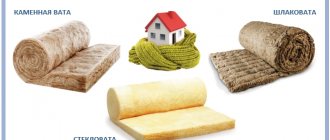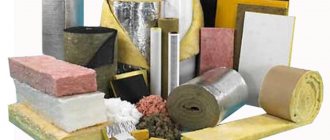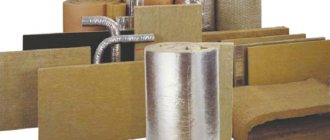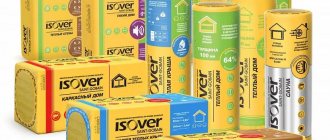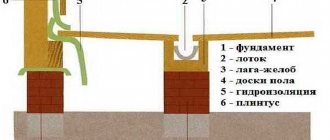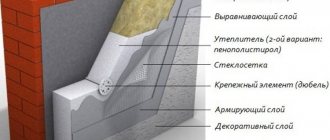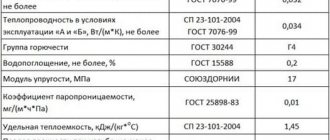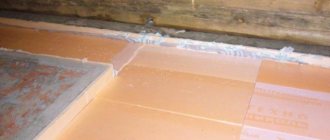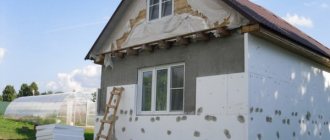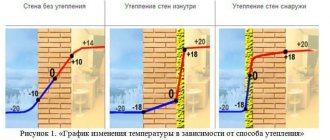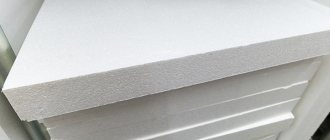Main characteristics of insulation
In its structure, mineral wool consists of small fibers, they are obtained as a result of heating rocks to a high temperature, and its characteristics are noticeably superior to the previously widespread glass wool.
Appearance of insulation
Penoplex is an improved foam plastic; it has more positive qualities, but is also more expensive. These insulation materials differ in composition and production technology.
- Thermal insulation properties. Mineral wool has a coefficient of 0.032-0.046; penoplex has a coefficient of 0.03-0.032. Heat loss is lower with a lower rate, so the heat inside the room is better retained;
- Life time. Penoplex is a material with increased strength, it crumbles poorly, practically does not dry and does not rot. The insulation does not lose its qualities when properly stored - in a cool room, protected from sunlight. Mineral wool also does not dry out, in the absence of physical activity it can be used for a long time, it is not afraid of heat and low temperatures, and is not afraid of sunlight. Bacteria and mold cannot grow in this material. But without proper fastening, mineral wool settles, crumbles and slides down the wall. Both heat insulators can last at least 50 years;
- Ecological properties. Both insulation materials are produced without using toxic materials that can harm humans. But they need to be installed, creating a barrier to prevent small particles from getting into the air;
- Ease of installation. When insulating with penoplex, it is easier to create a very flat surface. It is easy to process and sand, and the L-shaped edge eliminates cold bridges. It is not necessary to install a vapor barrier for it; if there is no tongue-and-groove edge, you will have to lay the material in 2 overlapping layers or seal the seams. Mineral wool weighs a little more, but retains heat much better, makes installation work easier, and is easier to install on disproportionate structures. But the job requires protective clothing;
- Insulation. When thermally insulating the facade of a house, you need a layer of penoplex with a thickness of at least 50 mm, while the layer of mineral wool must be at least 60 mm;
- Moisture absorption. Penoplex absorbs little moisture, and mineral wool can become completely saturated, losing some of its properties. Penoplex is much better, especially in regions where it often rains;
- Fire resistance. Mineral wool perfectly withstands high temperatures and does not burn. Can only melt at temperatures exceeding 1000 degrees. It contains a small amount of adhesive base that can catch fire, but it is very small. Penoplex melts and burns;
- Price. The costs of purchasing both insulation materials are almost the same. There is a slight difference only when choosing a manufacturer.
What is better for floor insulation - mineral wool or penoplex
Everything is simple here; for wooden floors, mineral wool is the best solution. Moreover, mineral fiber is best suited for insulating ventilated floors in a bathhouse, summer kitchen, and even in an apartment.
EPS is used when installing insulation under a concrete screed, finishing floors with tiles, or when laying water-heated floor coverings.
What is better to insulate walls - mineral wool or penoplex
Oddly enough, the choice of a suitable insulation material depends to a greater extent on the heating mode of the room and the vapor permeability of the walls than on the thermal insulation coefficient.
For walls with zero or extremely low levels of water vapor release, foamed polystyrene is used
If the walls are made of brick, adobe, or the frame is assembled from wooden sleepers or timber, then mineral wool replaces penoplex. With the obligatory equipment of vents and ventilation gaps, and the facade and walls must be covered with wind protection and cladding.
For a summer cottage or bathhouse, the indicators are not at all important whether mineral wool or penoplex is warmer. In this case, you need to use a material with high vapor permeability. In addition to high resistance to fire, such insulation very well removes water vapor from the building, even before the stove in the room cools down.
What is better for insulating the roof and attic - penoplex or mineral wool and penoplex
Extruded polystyrene foam is practically not used for arranging roofing pie. The reason lies in the need to remove warm water vapor entering the under-roof space from living quarters from the insulation system.
An exception may be attic rooms, in which the insulation of the floor and internal walls of the room is made of EPS, and the general roof is equipped with thermal insulation based on mineral wool.
What is better to insulate the ceiling - penoplex or mineral wool?
Foamed polystyrene is allowed to insulate the ceiling in the following cases:
- The ceiling is made of reinforced concrete slab or cement-sand screed;
- The room is not heated, for example in the case of a garage, summer kitchen or outbuilding where there is no heating system.
In other cases, the ceiling insulation is based on mineral fiber. There are also schemes for thermal insulation of the ceiling with foam insulation with additional supply and exhaust ventilation of the ceiling space.
For your information! If you insulate without ventilation, then condensation and fungus will certainly appear on such thermal insulation.
The better way to insulate a balcony, loggia, mineral wool or penoplex
For unheated rooms it is easier and more convenient to lay sheets of extruded polystyrene foam. Good ventilation will ensure reliable removal of water vapor, regardless of time and air temperature outside.
In heated loggias and balconies, mineral wool will be more effective in a number of ways, but only if the insulation is installed on external walls.
If the balcony is glazed with plastic, you can also insulate it with EPS, but be sure to install vents to remove condensate
Comparison by main parameters
Penoplex - produced on the basis of polystyrene, with the addition of special chemicals. They turn into a kind of foam under the influence of high temperature. Ready-made porous insulation is entering the market.
Penoplex
Often it contains substances that prevent thermal oxidation and flame retardants that resist combustion. The main characteristics of penoplex almost do not change under the influence of moisture. Therefore, it is permissible to use it to protect a building from cold outside and inside. There is no need to protect it from moisture.
A room insulated with penoplex
It is necessary to prevent the possibility of contact with ethers, tar, oil paints, fuels, lubricants and formaldehyde. These substances will lead to the decomposition of penoplex.
Mineral wool is produced by melting rocks, and after heating, thin fibers are formed.
Important! A huge advantage of mineral wool is that it contains exclusively natural substances that can withstand open fire and reliably protect against street noise.
Mineral wool
Mineral wool is sold in the form of rolls or slabs, allowing you to protect surfaces of any configuration from the cold. It is not able to withstand moisture; even dampness significantly impairs the thermal insulation qualities.
There are several varieties of mineral wool, differing in characteristics:
- Glass wool. They are used for thermal insulation of non-residential premises, the reason is that it contains formaldehyde, but its cost is the lowest;
- Slag-like. Well suited for protecting heating pipes and external surfaces of buildings;
- Stone wool. The material is very durable. But it absorbs a lot of moisture;
- Basalt wool. It does not burn at all, successfully protects against street noise, but absorbs a lot of moisture.
Laying mineral wool
It is difficult to say which is better for protection from the cold than penoplex or mineral wool; the choice mainly depends on the surfaces that need protection. Penoplex is a little lighter and is convenient to use for flat surfaces. When using mineral wool, remember to wear protective clothing.
You can insulate rooms inside the house with any material. Penoplex is convenient to use on flat surfaces. It sticks securely and is easy to cut and sand. But in areas of the building where many turns and curves can be found on the surface, it is advisable to fix mineral wool; it easily fits on surfaces of any curvature.
What is better to insulate with polystyrene foam?
This material has proven itself very well in places where air humidity is quite high but insulation is required.
- Foam plastic will not do anything when in contact with wet ground, so it can perfectly insulate foundations, as well as various engineering structures located underground. Tens of years will pass, and the insulation will remain the same as at the very beginning. It is often used in the construction of multi-layer foundations as a middle layer. It turns out to be a very reliable and high-quality foundation.
- When building houses without basements, on a monolithic foundation, it is also convenient to use polystyrene foam. Plates of this material are laid on a leveled area, and then a layer of concrete is poured on top of them. The slabs themselves can be either one row or several. After the concrete has hardened, the walls of the house begin to be erected.
- To prevent the foundation of the house from freezing, it is very effective to insulate not only its vertical, but also its horizontal part with polystyrene foam. Expanded polystyrene slabs are laid along the foundation. Then they are backfilled, if necessary, additionally laying a waterproofing layer. This method of insulation reliably protects the foundation from frost.
- The walls of houses (both inside and outside) can also be effectively insulated with polystyrene foam. It is best if these walls are block or brick. A high thermal insulation effect is achieved when using polystyrene foam to insulate interior spaces, and the formation of a dew point is not observed.
- For non-ventilated roofs (warm, flat roofs), the PSBS grade of expanded polystyrene is used. A waterproofing layer must be placed on top. For cold roofs that are ventilated, thermal insulation is carried out differently. The inside of the roof is insulated with polystyrene foam, leaving space for ventilation. This prevents water vapor from condensing.
- It is also good to insulate floors and ceilings between floors with foam boards. A layer of insulating material is placed under them, and concrete is poured on top.
- A variety of packaging is also made from polystyrene foam, and it is also used for thermal insulation of refrigerators, freezers and special isothermal vans.
What's better
The insulation that you will use when building a house must meet the climate requirements of your area. The choice of a particular material is directly influenced by the quality of the surface requiring thermal insulation.
Important! Wooden buildings should not be insulated with penoplex. Its use will cause wood rotting. For buildings built from timber, it is advisable to use mineral wool with a reliable waterproofing layer.
It is advisable to do the thermal insulation of a loggia or balcony using penoplex. This material is denser in structure; for installation it is not necessary to fill the lathing, which will make it possible to save space.
Thermal insulation of private houses is best done with mineral wool. Cooled air will not pass through it, it does not burn, and it is easy to lay it in the voids of the sheathing. The characteristics of all thermal insulation materials differ markedly; it is difficult to say which is warmer; the choice of a particular insulation is directly influenced by the conditions of its use.
What is better to insulate with stone wool?
Mineral wool is well suited for buildings that are built from breathable materials, for example, wood or brick. In general, it combines well with all coatings, and has no exceptions.
According to some indicators, materials differ specifically, and their choice should be made based on the conditions in which they will be located. It is almost impossible to say which of them is better, because each of them is good in its own way.
In recent years, a huge number of insulation materials have appeared among construction and repair materials. Each of them is good in its own way and has some advantages over others. Among a number of thermal insulation materials, much attention is paid to penoplex and mineral wool.
Penoplex – extruded polystyrene foam
Tile-type insulation, which has high thermal insulation properties due to the presence of small cells containing air.
This product is easy to identify - it has a bright orange color. Due to its high strength, Penoplex is used for outdoor work. This is confirmed by the names that this or that type of insulation bears: roof, wall, foundation, 45, comfort. Comfort is suitable for various jobs, 45 can even be used in road construction and bridge construction.
The manufacturer of this insulation is Penoplex. The operating temperature ranges from -50% to +75C, the percentage of water absorption is slightly higher - 0.4, however, this is also a very good indicator.
Advantages and disadvantages
- Low moisture absorption.
- High compressive strength.
- Long service life.
- Affordable price.
- Quick installation.
The disadvantages include a high fire hazard, but Technoplex also has this nuance.
What is better for sound insulation - penoplex or mineral wool?
It is known that properly laid mineral wool blocks noise several times better than EPS. But this state of affairs in comparing the sound insulation of penoplex and mineral wool persists only under ideal conditions.
In practice, when laid on walls, the wool often sags and exposes the joints between the mats. Weak areas appear in the thermal insulation, through which noise enters the room and heat escapes. If the insulation also gets wet, then its noise insulation capabilities deteriorate sharply.
More or less acceptable noise insulation performance can be achieved using XPS. You can use material with a profiled surface, or thermal insulation with polystyrene foam is performed in several layers with overlapping seams. Additional air gaps appear between the insulation boards, due to which the quality of sound insulation increases significantly.
